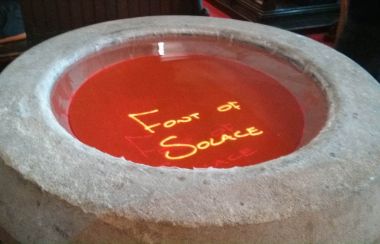Church uses Harry Potter tech to bring prayer to life

Many churches have got used to PowerPoint projection in their services. But the church of St Peter's in Hackney, London has taken its engagement with technology to a whole new level this Advent and Christmas.
In partnership with Project CEDE ('Creating and Exploring Digital Empathy') the church is hosting an experimental installation which lets people interact with different parts of the building digitally, in a prayerful and profoundly spiritual way.
A digital votive candle stand is positioned next to the church's traditional candle stand. Visitors can type prayers and prayer requests which are then projected in a prayer corner in the south aisle, once used as a Lady Chapel, where for many years daily prayers and weekday masses were offered.
Another element is a projection of prayers from inside the building through a window at night, so that words and images could be seen from the street.
There is also a 'Font of Consolation' which has echoes of the famous 'Pensieve' in the Harry Potter films – a magical water-filled bowl in which words and images appeared to the user. CEDE has designed a lining for the font, on to which text and images can be projected. In the plinth next to it there is a tablet on which messages can be written. They appear in the water and seem to dissolve. CEDE's Dr Andrew Hudson-Smith told the BBC: "You can hand-write your worries, your concerns, your sins perhaps, and you can put your hands into the holy water...you see your worries and your sins floating away, almost in a Harry Potter-esque way."
He said: "We chose a church because it's the perfect place where you share the deepest bits of your soul. The missing thing in our lives at the moment is a sharing of our empathetic thoughts."
The church's minister, Rev Julia Porter-Pryce, told Christian Today that her involvement had come about because she was researching the use of church spaces. She had provided the theological and liturgical input to the project, while CEDE had provided the technical assistance.
The installation has been open for two hours a day during Advent. "People like to come in and sit quietly," she said. "I have had more conversations about prayer during the last three weeks than in the last 12 years."
She explained: "When you light an ordinary votive candle you don't usually articulate a prayer, you tend to communicate a feeling or a thought. Using a tablet to type a message makes you articulate a prayer in a particular way. It's as though you can see what's in another person's head, and there's something quite holy about that."
Porter-Pryce said that she had been concerned that the installation would be seen simply as entertainment, but that it had been a very helpful way of encouraging people to explore prayer. She suggested that there was potential for its wider use, saying: "I can see the same devices being used in a cathedral or a country church and they would work in the same way."
CEDE's mission is "to unlock the digital communication of empathy as we believe it is a major emission from online communication and digital personhood as a whole". It is a cross-disciplinary project involving the Bartlett Centre for Advanced Spatial Analysis at University College London, Lancaster Imagination Lab and the Institute for Economic Analysis of Decision-making at the University of Sheffield.











